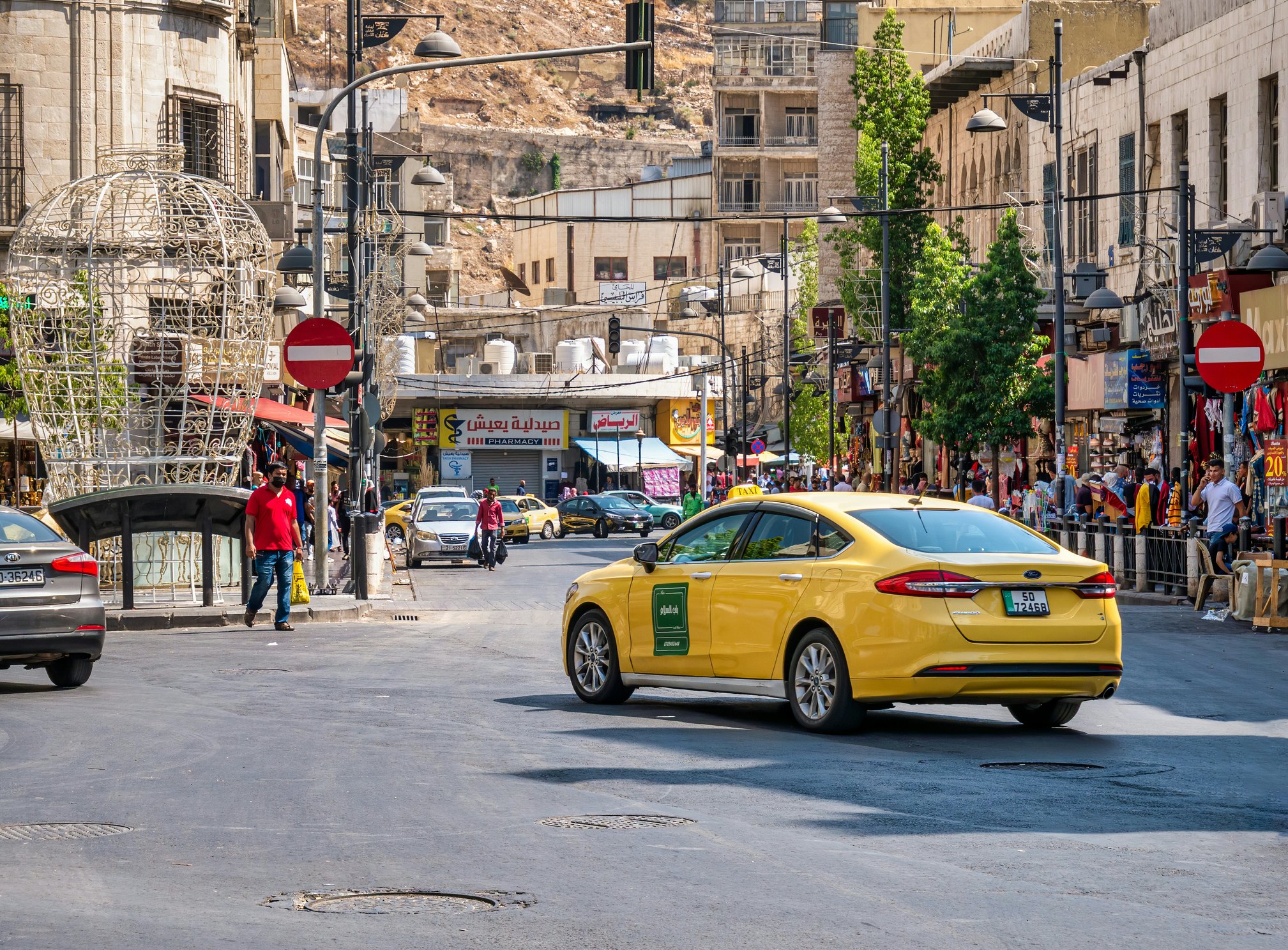

Have your own vehicle means you can visit more remote parts of Jordan © Oleh_Slobodeniuk / Getty Images
You can cover a lot of ground on your first visit to Jordan, given its small size (it’s less than three-quarters the size of New York State).
But the unique rules of the road, lack of reliable public transportation options and the long stretches of desert highway between popular spots such as Amman and Petra mean that getting around Jordan requires a bit of planning.
Whether you need a car, opt for the bus or even travel by foot, the best way to get around Jordan depends on your preferences, budget, itinerary and travel style. Here’s some insight to help you decide how to get around.
Driving gives you flexibility but can be stressful
Renting a car in Jordan has both advantages and challenges – it's all about weighing the pros and cons to decide if it's worth the effort for you. Jordanian driving can be aggressive, people pass on both sides and park wherever they like (including, sometimes, in the middle of the road), lines and signs seem to be suggestions rather than rules, horns are used excessively and signal lights are abandoned.
All of this means driving here is not for the faint of heart. But if you’re confident behind the wheel and can adapt to the local style of driving, renting a car gives you the freedom to visit major sites at your own pace. You can also access places off the beaten path such as the pre-Roman ruins near Iraq Al Amir, which saves you the cost of hiring a driver or booking a guided tour.
How to rent a car in Jordan
Rental-car agencies are abundant in the larger cities, such as Amman and Aqaba, where you’ll find international companies such as Hertz and Thrifty as well as locally owned outfits. You may be able to barter with the latter for a lower rate, though booking online in advance can offer a guaranteed rate and peace of mind. Be aware that many businesses are closed on Fridays. If you need a car for the weekend, call ahead to check operating hours, or plan to pick it up on Thursday.
The minimum age to rent a car in Jordan is 21 (with a surcharge for drivers under 25), and you’ll need to show your driving license. By law, an international driving license is required to drive in Jordan, but car rental agencies may not ask for one. Err on the side of caution and bring it anyway; just don’t be surprised if no one asks to see it.
The car you need will depend on your itinerary
Choose a vehicle suited to your itinerary: economy size for main highways and cities where parking spots may be small and difficult to come by, or a 4x4 if you’ll be off-roading or driving in the desert dunes (which we don’t recommend unless you are highly experienced with driving in soft sand).
Before you leave the rental car lot, have a good look at the car inside and out, and note any damage so that you won’t be held responsible when you return the car. Don’t forget to test the heating and air conditioning: the weather in Jordan can be extreme and you don't want to be stuck on a road trip without heat or A/C.
If you’re keen on road trips and getting behind the wheel yourself, you will miss out on the cultural and historical context that a driver or tour guide provides. Consider hiring a guide for sites such as Jerash, Petra and Wadi Rum, where local knowledge and storytelling add value, depth and even friendship to your experience. Spending time with local guides allows you to experience Jordanian hospitality, learn from those who know Jordan best and contribute to the local economy.

What you need to know before hopping in a taxi in Jordan
Traditional yellow taxis are available in cities but aren't as common in remote areas. If you opt for a taxi, be sure to agree on the destination before you set off and ask the driver to turn the meter on right away. Drivers are required by law to do so – if they refuse, you can get out. Keep cash in small denominations to hand, since Jordan is still largely cash-based and taxi drivers may not accept or be able to give change for bills larger than JD5.
While there are plenty of friendly drivers, some travelers have encountered harassment and overcharging when hailing taxis, so it may be worth paying a bit more for a ride-sharing service.
Uber and Careem are readily available in the main cities, and you can easily schedule and pay through the apps. Because the drivers are regulated by their respective companies, the cars tend to be cleaner, and you have the added peace of mind that your ride is tracked. They do tend to be pricier than taxis, though, and you may have a longer wait during busy times, especially during rush hour, public holidays and Thursday nights. When planning your day, always factor in extra time for traffic.
Whether you choose a traditional taxi or a ride-share service, be aware of social expectations: if the driver is male, male passengers are expected to sit in the front and females in the back. There are some female ride-share drivers in Jordan, so if one picks you up, the expectation is reversed: female riders can sit in the front, but male riders should sit in the back.
If you’re a non-smoker, you may be better off renting a car or hiring a private driver – it’s not uncommon for taxi drivers to smoke while transporting passengers. Although Uber prohibits it, some may smoke just before picking up a passenger, leaving unpleasant residual smoke in the car.
Take the bus for the adventure, not the convenience
City buses do exist in Jordan, though the public transportation system can be unreliable and limited in reach. Timetables are hard to come by and buses generally don’t run between locations that are popular with visitors, so you may want to skip this option. Of course, if you have time to spare and are simply interested in the experience of sharing a bus with everyday Jordanians, you should give it a try. Ask your hotel or travel operator for information on routes, as you’re unlikely to find up-to-date info online.
There are also inter-city minibuses, though you’ll need some patience and Arabic language skills if you want to take one. They tend to depart only when full, which can mean waiting for an undetermined amount of time. Plus, you’ll need to ask around for departure and destination locations.
Roomier, air-conditioned JTT buses cover several tourist-friendly routes including Amman to Petra or Aqaba, and Aqaba to Wadi Rum. JTT also offers daily tours to some popular sites as a convenient package deal. Routes and timetables are available online and tend to be reliable but the schedule can change – it’s best to call directly or go in person to the head office to book your ticket.
Use the airport shuttle bus if you’re on a budget
If you’re looking for an airport shuttle to central Amman from Queen Alia International Airport, the Sariya Airport Express bus is great for those on a budget. The Airport Express gets mixed reviews and does not drop passengers off at hotels, so if you’re in a rush or prefer direct, private transportation, a taxi or Uber is best.

Guided tours are the most stress-free way to get around Jordan
If you want to leave the driving in Jordan to the pros, the most stress-free way to get around is a guided tour. While these may cost more than a bus or rental car, you can sit back and enjoy your experience while the tour operator handles all of the logistics – and the traffic. A guided tour also provides you with local insight, any required equipment (such as helmets for canyoning), safety, support and the chance to meet other travelers. Sharing transportation with others means reducing your carbon footprint as well.
If you want the freedom of a self-drive experience without the stress of navigation, opt for a customized private tour, or build your own itinerary and hire a driver.
Insider tip: Some rental car companies offer car-and-driver services. Reliable private drivers are often shared by word of mouth and on social media groups, such as EXPATS in Amman – a great place to seek out recommendations.
Flying is not the best way to get around Jordan
Given Jordan's size, most visitors opt for a car, bus or guided tour to get between Amman and Aqaba or Wadi Rum. However, there are domestic flights between Amman and Aqaba. This one-hour flight will cost around JD50 to JD130, depending on the season and availability. Though the flight time is short, you’ll need to factor in the time it takes to get to the airport in traffic and the check-in time once there.

Tips for getting around Jordan on foot
At first glance, Jordan does not appear to be a pedestrian-friendly place. The weather can be extreme, sidewalks are broken or nonexistent, there are no subways or trains and Amman’s steep hills can be challenging – especially in the hot summer sun. But walking is in fact deeply embedded in Bedouin culture, and if you follow in the footsteps of those that came before, you will understand why it is one of the best ways to get around Jordan.
While walking is generally not the best way to get around Amman, in some areas – such as Rainbow St, Al Webdeh and Al Balad – it’s a fun way to experience the city. When you set out, be sure to carry plenty of water and snacks, and wear sun protection and sturdy shoes.
Outside of urban areas, stick to designated trails. Thanks to the Jordan Trail, a 675km (420-mile) through-hike from Umm Qais in the north to Aqaba in the south, you can cross the country from top to bottom on foot. If you have the time (it takes between 30 to 45 days to complete, depending on your pace) and ability, this is the most eco-friendly and incredible way to experience Jordan. You’ll trek the country’s varied terrain, pass through dozens of villages, walk Bedouin trails and visit archeological and UNESCO World Heritage sites including Gadara, Jerash, Petra and Wadi Rum.
Insider tip: Avoid hitchhiking. If you are planning to travel a long distance but not follow the Jordan Trail route, consider renting a car for the longer stretches and plan to hike or walk once you’ve reached your destination.
Accessible transportation in Jordan
Options for accessible transportation in Jordan are extremely limited, so visitors should check with their tour operator well in advance for any accommodations needed. Private transportation is the best option for travelers with accessibility needs. Accessible Jordan is a great resource for the most up-to-date options. Check out Lonely Planet's accessible travel hub for more advice.
















